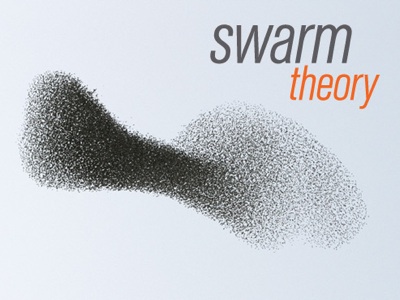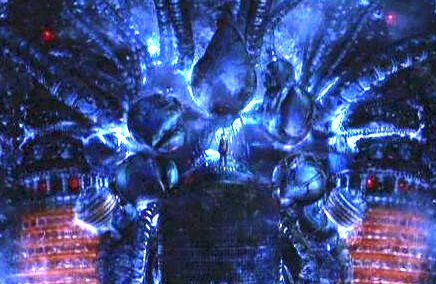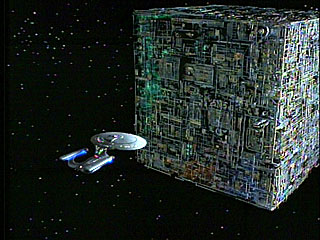The Bottom is Not Enough
[Translations: Japanese]
I wrote a book, Out of Control, heralding the immense power of bottom up systems. You know: smart mobs, hive mind, web power, amateur hour, decentralized webs, network effects, and collaborative work. Twenty years ago Out of Control made a wide-ranging and exhaustive case for the remarkable things which decentralized, out-of-control systems can accomplish in biology, technology, and cultural realms. Two decades later I’m still keen on the untapped potential of emergent bottom-up systems.

But throughout my boosterism I have tried to temper my celebration of the bottom with my belief that the bottom is not enough for what we really want. To get to the best we need some top down intelligence, too. I have always claimed that nuanced view. And now that crowd-sourcing and social webs are all the rage, it’s worth repeating: the bottom is not enough. You need a bit of top-down as well.
The reason every bottom-up crowd-source hive-mind needs some top-down control is because of time. The bottom runs on a different time scale than our instant culture.
Here’s how I come to that conclusion. I call myself an editor first, and author second. I think the top-down function of editors — to select, prune, guide, solicit, shape, and guide the results from the crowd — is essential to excellence. From the earliest days of the web, when Wired originated one of the first commercial content websites, a key unanswered question was how much influence editors should wield? In the early 1990s, adhocracy folks such my friend Howard Rheingold (whom we hired to oversee Hotwire, the online content site for Wired), argued for the editor-less crowd. I was on the side of editors.
Howard was at the forefront in the then totally radical belief that content could be assembled entirely from the collective action of amateurs and the audience. I had no doubt that a lot of good stuff could be assembled this way. But I thought of that crowd-sourced content as just the start. I believed then, and still believe now, that the role of editors — what we might call middle people, the PSL (publishers, studios, and labels) — were NOT going to go away. I thought that by adding a mild, smart editorial choice on top of the bottom’s work, you’d have something much better. Howard believed that we’d get further faster just relying on people with strong voices, lots of passion, and the willingness to write. We’d call those bloggers now.
My argument was that the publisher roles would change drastically, but the need for some top-down selection and guidance would only increase in value. As the amount of content expanded, the demand for some intelligent guidance and selection would be worth a lot to some people. The work of most unedited amateurs was simply not interesting or reliable enough for me.
Ten years later no one was as shocked as I was to see the Wikipedia disprove this notion, and show how well the bottom could work without any editors at all. Howard was right. For better or worse, the Wikipedia now represents power from the bottom up, the decentralized apex of editor-less knowledge, out-of-control goodness, and infamous the hive mind. Wikipedia is not the only hive mind out there. There’s the grand web itself, and other collective entities, such as fandoms, voting audiences, link aggregators, consensus filters, opens source communities, and so on, all basking in a rising tide of loosely connected communal action.
But it doesn’t take very long to discover — if we look hard and honestly — that none of these innovations is pure hive mind, and that the supposed paragon of adhocracy — the Wikipedia itself — is itself far from strictly bottom-up. In fact a close inspection of Wikipedia’s process reveals that it has an elite at its center, (and that it does have an elite center is news to most). Turns out there is far more deliberate top-down design management going on than first appears. This is why Wikipedia has worked in such a short time.
Time is what ad-hoc systems need, which we have so little of. The main drawback to pure unadulterated darwinism is that it takes place in biological time — eons. Who has eons to wait during internet time? Nobody. Which is where Jimmy Wales enters the picture.
Jimmy Wales, head honcho of Wikipedia, and and an emergent association of volunteer editors created a practice that allowed the Wikipedia to be smarter in a few years than pure dumb bottom-up evolution would allow. Rather than try to struggle to devise waterproof bottom-up legalistic rules to keep persistent vandals from messing up articles, uber-admin Wales would simply ban them unilaterally on the advice of his elite editors. A human editor could discern much better than any rule whether the trolls meant trouble or where harmless. Saved years of wasted effort trying to tweak and tune an emergent anti-troll system.

It is important to remember how dumb the bottom is in essence. In biological natural selection, the prime architect is death. Death powers evolutionary selection. Death is one binary bit. Either off or on. What’s dumber than that? So the hive-mind of evolution is powered by one-bit intelligence. That’s why it takes millions of years to do much.
We are too much in a hurry to wait around for a pure hive mind. Our best technological systems are marked by the fact that we have introduced intelligent design into them. This is the top-down control we insert to speed and direct a system toward our goals. Every successful technological system, including Wikipedia, has design wired into it.
What’s new is only this: never before have we been able to make systems with as much “hive” in it as we have recently made with the web. Until this era, technology was primarily all control, all design. Now it can contain both design and no-design, or hive-ness. In fact, this Web 2.0 business is chiefly the first step in exploring all the ways in which we can combine design and the hive in innumerable permutations. We are tweaking the dial in hundreds of combos:
1) dumb writers, smart filters, no editors.
2) smart writers, dumb filters, no editors
3) smart editors, smart filters, no writers
…ad infinitum.
The exhilarating frontier today is the myriad ways in which we can mix out-of-control creation with various levels of top-down control. We are rushing into an expanding possibility space never accessible before. It’s the 5th dimension of “no one is as smart as everyone.” A recurring insight (but still worth exploring) is simply: what happens if we turn it inside out and have the audience/customers in charge? As Clay Shirky puts it: here comes everybody! But pure unadulterated dumb mobs is the easiest, perhaps least interesting new space in the entire constellation of possibilities. More potent, more unknown, are the many other combinations of everyone and someone.

It’s taken a while but I think we’ve learned that while top-down is needed, not much of it is needed. Editorship and expertise are like vitamins. You don’t need much of them, just a trace even for a large body, and too much will be toxic, or just pissed away. But the proper dosage of intelligent control will vitalize the dumb hive mind.
Yet if the hive mind is so dumb, why bother with it at all?
Because as dumb as it is, it is smart enough.
More importantly, the brute dumbness of the hive mind produces the raw material that smart design can work on. If we ONLY listen to the hive mind, that would be stupid. But if we ignore the hive mind altogether, that is even stupider.
Yet because the hive mind works at a slower pace on a different time scale, there’s a bottom to the bottom. I hope we realize that a massive bottom-up effort will only take us part way — at least in human time. In the realm of encyclopedias, we want totally reliable articles that are the most authoritative in the world, the most understandable in the world, and the most current in the world. We want news that is relevant, with a low noise to signal ratio. We want research reports that are unbiased but comprehensive and consistent. We want expertise.
We are unlikely to get the level of expertise we want with no experts at all.
That’s why it should be no surprise to anyone that in the long run more and more design, more and more control, more and more structure will be layered into the Wikipedia. (The Citizendium is one hint of where it is headed.) I would guess that in 50 years a significant portion of Wikipedia articles will have controlled edits, peer review, verification locks, authentication certificates, and so on. That’s all good for us readers.

I know it is heresy, but it might be that the Wikipedia model is not good for very much more than writing universal encyclopedias. Other wiki projects to construct textbooks, species listings, and a search engine have not succeeded — yet. Perhaps the article length is fortuitously the exactly right length for the smart mob, and maybe a book is exactly the wrong length. We’ll see.
However even if the 2006 Wikipedia process turns out to not be the best way to make a textbook, or create the encyclopedia of all species, or dispense the news, the 2056 Wikipedia process — with far more design in it — may be. It may be equally heretical to suggest that the improved editor-assisted hive mind will write far more of our textbooks, our databases and our newspapers than anyone might believe right now.
Here’s how I sum it up: The bottom-up hive mind will always take us much further than even seems possible. It keeps surprising us in this regard. Given enough time, dumb things can be smarter than we think.
At that same time, the bottom-up hive mind will never take us to our end goal. We are too impatient. So we add design and top down control to get where we want to go.
The systems we keep will be hybrid creations. They will have a strong rootstock of peer-to-peer generation, grafted below highly refined strains of controlling functions. Sturdy, robust foundations of user-made content and crowd-sourced innovation will feed very small slivers of leadership agility. Pure plays of 100% smart mobs or 100% smart elites will be rare.
The real art of business and organizations in the network economy will not be in harnessing the crowd of “everybody” (simple!) but in finding the appropriate hybrid mix of bottom and top for each niche, at the right time. The mix of control/no-control will shift as a system grows and matures.
Judged from where we start, harnessing the dumb power of the hive mind will always take us much further than we can dream. Judged from where we hope to end up, the hive mind is not enough; we need an additional top-down push.
Since we are only at the start of the start, it’s the hive mind all the way for now.


